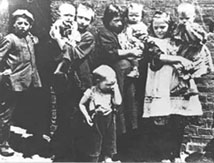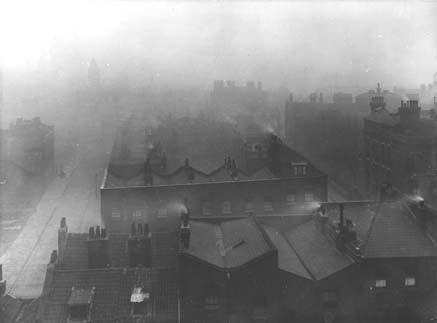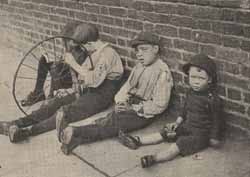Poverty and Families in the Victorian EraThis article by Barbara Daniels gives an overview of the causes
and the effects of poverty on poor families and children in Victorian Britain. Population increase
The nineteenth century saw a huge growth in the population of Great Britain. The reason for this increase is not altogether clear. Various ideas have been put forward; larger families; more children surviving infancy; people living longer; immigration, especially large numbers of immigrants coming from Ireland fleeing the potato famine and the unemployment situation in their own country. By the end of the century there were three times more people living in Great Britain than at the beginning. Growth of the citiesAlthough the population of the country as a whole was rising at an unprecedented rate, that of the towns and cities was increasing by leaps and bounds. This was due to the effects of the industrial revolution; people were flocking into the towns and cities in search of employment. For some it was also the call of the unknown, adventure and a better way of life. The search for employmentTherefore all these factors – population explosion, immigration both foreign and domestic – added up and resulted in a scramble for any job available. Large numbers of both skilled and unskilled people were looking for work, so wages were low, barely above subsistence level. If work dried up, or was seasonal, men were laid off, and because they had hardly enough to live on when they were in work, they had no savings to fall back on. Child labourChildren were expected to help towards the family budget. They often worked long hours in dangerous jobs and in difficult situations for a very little wage. For example, there were the climbing boys employed by the chimney sweeps; the little children who could scramble under machinery to retrieve cotton bobbins; boys and girls working down the coal mines, crawling through tunnels too narrow and low to take an adult. Some children worked as errand boys, crossing sweepers, shoe blacks, and they sold matches, flowers and other cheap goods.
The housing shortageLow wages and the scramble for jobs meant that people needed to live near to
where work was available. Time taken walking to and from work would extend an
already long day beyond endurance. Slum housingAll these problems were magnified in London where the population grew at a record rate. Large houses were turned into flats and tenements and the landlords who owned them, were not concerned about the upkeep or the condition of these dwellings. In his book The Victorian underworld, Kellow Chesney gives a graphic description of the conditions in which many were living: ‘Hideous slums, some of them acres wide, some no more than crannies of obscure misery, make up a substantial part of the, metropolis … In big, once handsome houses, thirty or more people of all ages may inhabit a single room,’ (1)
OvercrowdingMany people could not afford the rents that were being charged and so they rented out space in their room to one or two lodgers who paid between twopence and fourpence a day. Great wealth and extreme poverty lived side by side because the tenements, slums, rookeries were only a stones throw from the large elegant houses of the rich. The name ‘rookeries’ was given to these dwellings because of the way people lived without separate living accommodation for each family. The analogy being that whereas other birds appear to live in separate families, rooks do not. Neither did the very poor in the tenements of London. Poor sanitary conditionsHenry Mayhew was an investigative journalist who wrote a series of articles for the Morning Chronicle about the way the poor of London lived and worked. In an article published on 24th September 1849 he described a London Street with a tidal ditch running through it, into which drains and sewers emptied. The ditch contained the only water the people in the street had to drink, and it was ‘the colour of strong green tea’, in fact it was ‘more like watery mud than muddy water’. This is the report he gave: ‘As we gazed in horror at it, we saw drains and sewers emptying their filthy contents into it; we saw a whole tier of doorless privies in the open road, common to men and women built over it; we heard bucket after bucket of filth splash into it’ (2). Mayhew’s articles were later published in a book called London Labour and the London Poor and in the introduction he wrote: ‘…the condition of a class of people whose misery, ignorance, and vice, amidst all the immense wealth and great knowledge of “the first city in the world”, is, to say the very least, a national disgrace to us’ (3). DestitutionMany cases of death caused by starvation and destitution were reported. One example of such a report will suffice. In 1850 an inquest was held on a 38 year old man whose body was reported as being little more than a skeleton, his wife was described as being ‘the very personification of want’ and her child as a ‘skeleton infant’(4).
Homeless childrenObviously these conditions affected children as well as adults. There were children living with their families in these desperate situations but there were also numerous, homeless, destitute children living on the streets of London. Many children were turned out of home and left to fend for themselves at an early age and many more ran away because of ill treatment. In her book The Victorian town child, Pamela Horn writes: ‘In 1848 Lord Ashley referred to more than thirty thousand 'naked, filthy, roaming lawless and deserted children, in and around the metropolis' ' (5). Children and crimeMany destitute children lived by stealing, and to the respectable Victorians they must have seemed a very real threat to society. Something had to be done about them to preserve law and order. Many people thought that education was the answer and Ragged schools were started to meet the need. However there were dissenting voices against this. Henry Mayhew argued that: ‘since crime was not caused by illiteracy, it could not be cured by education … the only certain effects being the emergence of a more skilful and sophisticated race of criminals’ (6).
Society's attitude towards the poorIt does appear that many people and various agencies were becoming aware of
the problem, but the sheer scale of it must have seemed overwhelming. ‘the poor were improvident, they wasted any money they had on drink and gambling’; ‘God had put people in their place in life and this must not be interfered with because the life after death was more important’ are some of the comments people might have made. As far as the later comment is concerned, this is clearly demonstrated in a
hymn published in 1848 by Cecil Frances Alexander: Social charitiesAs the century progressed the plight of the poor, and of the destitute homeless children, impinged on the consciences of more and more people. The Victorian era can also be thought of as one of intense philanthropy. Many of our modern day charitable institutions, such as The Children's Society, have their roots at this time. Barbara Daniels, March 2003 ReferencesFor full publication details of the items listed below, links will take you to the Bibliography section of this website. 1. Kellow Chesney, The
Victorian underworld (Harmondsworth: Penguin, 1972) |








